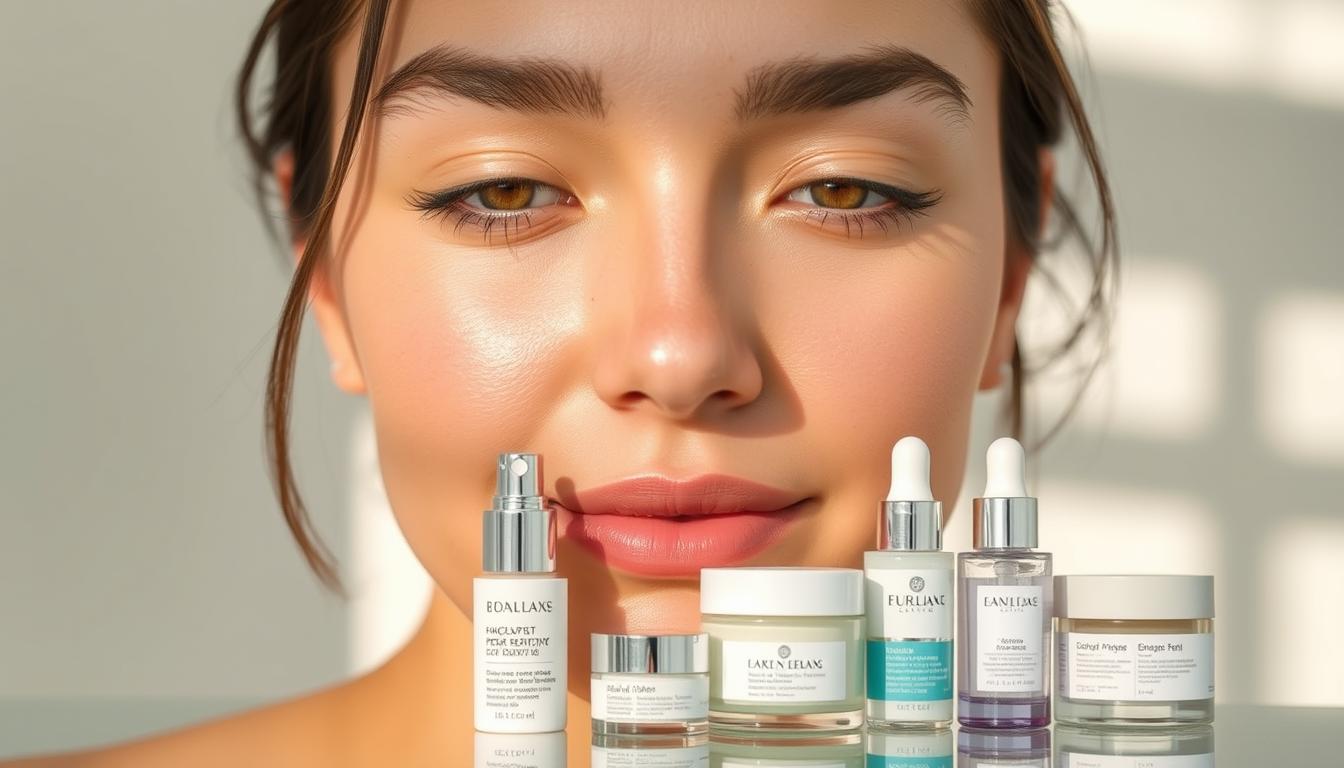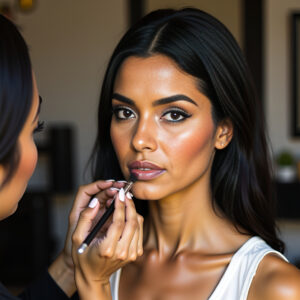Table of Contents
Skincare for hyperpigmentation is a common concern that affects people of all skin tones and ethnicities. Whether caused by sun damage, hormonal changes, or inflammation, it can leave behind stubborn dark spots that are hard to fade. Understanding the root cause is the first step toward effective treatment.
Sun exposure is one of the leading culprits, but conditions like melasma—often linked to hormones—affect up to 50% of certain populations. The good news? With the right approach, you can achieve clearer, more even-toned skin.
This guide combines dermatologist insights and proven treatments to help you tackle hyperpigmentation. From daily sun protection to powerful ingredients like vitamin C and retinoids, we’ll explore solutions tailored to your unique needs. Prevention is key, so SPF 50 is your best friend!
Ready to transform your skin? Let’s dive in.
Key Takeaways
- Hyperpigmentation affects all skin tones and ethnicities.
- Sun damage and hormonal changes are common causes.
- Melasma impacts up to 50% of certain populations.
- Daily sun protection is essential for prevention.
- Vitamin C and retinoids are effective treatments.
- Results from topical products typically take 3 months.
- Personalized approaches work best for different skin types.
What Is Hyperpigmentation and Why Does It Occur?
Dark spots and uneven skin tone can be frustrating, but understanding their cause is the first step to addressing them. This condition occurs when melanin, the pigment responsible for skin color, is overproduced in certain areas. The result? Patches that appear darker than the surrounding skin.
Understanding Melanin Production
Melanin is produced by cells called melanocytes. These cells work to protect your skin from harmful UV rays. However, when exposed to too much sun or other triggers, melanocytes can go into overdrive, leading to uneven pigmentation.
Blue light from screens and environmental stressors can also disrupt melanin regulation. This is why protecting your skin daily is so important.
Common Causes of Hyperpigmentation
Several factors can trigger this issue. Sun exposure is a major culprit, but it’s not the only one. Acne and other forms of inflammation can leave behind dark marks, especially in darker skin types. Studies show that post-inflammatory hyperpigmentation affects up to 61% of people with deeper complexions.
Hormonal changes, like those during pregnancy or due to thyroid conditions, can also lead to melasma. This condition is more common in women, with a 39:1 female-to-male ratio. Other triggers include certain medications and even laser treatments, which can sometimes worsen pigmentation issues.
Understanding your skin’s unique needs is crucial. The Fitzpatrick scale, which categorizes skin types based on their response to UV exposure, can help tailor treatments effectively.
Types of Hyperpigmentation You Should Know
Not all dark spots are the same—knowing the type is crucial for effective care. From sun exposure to hormonal shifts, pigmentation issues vary widely. Understanding these differences helps you target the root cause and choose the right treatment.
Sun Damage Hyperpigmentation
One of the most common types is caused by prolonged sun exposure. Known as solar lentigines, these spots often appear on the face, hands, and chest. They’re a direct result of UV rays triggering melanin overproduction.
Unlike freckles, solar lentigines don’t fade in winter. They’re a sign of cumulative sun damage. Daily SPF and treatments like IPL can help reduce their appearance. In fact, studies show a 90% improvement in pigmentation after just two IPL sessions.
Post-Inflammatory Hyperpigmentation (PIH)
This condition occurs after inflammation, often due to acne or cosmetic procedures. When the skin heals, it can leave behind dark marks. PIH is more common in deeper skin tones, affecting up to 61% of individuals.
Prevention is key—avoid picking at blemishes and protect your skin from irritation. Treatments like vitamin C serums and gentle exfoliation can speed up fading. Remember, patience is essential; results take time.
Melasma
Often called the “mask of pregnancy,” melasma is linked to hormonal changes. It appears as symmetrical patches on the face, usually on the cheeks, forehead, or upper lip. This condition is more common in women, with a 39:1 female-to-male ratio.
Melasma can be stubborn, but sun protection is a game-changer. A Mexican study found a 67% improvement with UV/VL sunscreen. Iron oxide sunscreens are particularly effective, as they block visible light, which can worsen melasma.
Familial patterns also play a role—61% of cases show a genetic link. If you’re prone to this condition, consult a dermatologist for a tailored approach.
How to Prevent Hyperpigmentation from Worsening
Preventing dark spots from worsening starts with simple, daily habits. With the right approach, you can protect your skin and maintain an even tone. Let’s explore how to keep pigmentation issues at bay.

The Role of Sunscreen in Prevention
Sunscreen is your first line of defense against pigmentation. UV rays can penetrate glass, so even indoors, SPF50 is crucial. Dr. Rattan emphasizes that daily use can prevent further damage and keep your skin healthy.
Iron oxide sunscreens are particularly effective. They block visible light, which can worsen pigmentation. A Moroccan study showed a 53% reduction in melasma with SPF50+ use. Reapply every two hours for maximum protection.
Daily Habits to Protect Your Skin
Beyond sunscreen, adopt habits that shield your skin. Wear UPF clothing and wide-brim hats outdoors. Avoid peak sun hours (10 AM to 4 PM) when UV rays are strongest.
Antioxidant-rich diets can also help. Foods like berries and leafy greens combat free radicals that harm your skin sun health. Avoid harsh scrubs or exfoliants, as they can irritate and worsen pigmentation.
Blue light from screens can also affect your skin. Use SPF-infused makeup for added protection. Dr. Jack notes that even in winter, melasma patterns can persist, so stay consistent with your routine.
By making these small changes, people can protect their skin and prevent pigmentation from worsening. Prevention is always easier than correction.
Skincare for Hyperpigmentation: Essential Steps
Achieving a brighter complexion starts with a solid daily routine. The right steps can make all the difference in reducing dark spots and improving your skin’s overall health. Let’s explore the key practices that deliver lasting results.
Cleansing and Exfoliating
Cleansing is the foundation of any effective routine. Start with a pH-balanced cleanser to remove impurities without stripping your skin. Double cleansing, especially at night, prevents pore congestion and prepares your skin for treatments.
Exfoliation is equally important. Chemical exfoliants like glycolic acid (5-10%) gently remove dead skin cells, enhancing product penetration. For darker skin tones, mandelic acid is a safer option, as it’s less likely to cause irritation.
Over-exfoliation can harm your skin barrier. Stick to 2-3 times a week for best effects. Pair exfoliation with niacinamide to strengthen your skin’s natural defenses.
Incorporating Antioxidants
Antioxidants are a game-changer for evening out skin tone. Vitamin C and E work synergistically to brighten and protect against environmental damage. Apply these serums at night for maximum effects.
Dr. Idriss’s Major Fade Serum is a popular choice, combining multiple brightening agents. Layering antioxidants with other products can boost their effectiveness. Always follow with SPF in the morning to lock in the benefits.
| Step | Product Type | Frequency |
|---|---|---|
| Cleansing | pH-balanced cleanser | Twice daily |
| Exfoliating | Glycolic acid (5-10%) | 2-3 times weekly |
| Antioxidants | Vitamin C + E serum | Nightly |
By following these steps, you can create a routine that targets dark spots effectively. Consistency is key—stick with it, and you’ll see visible improvements over time.
Top Ingredients to Treat Hyperpigmentation
Finding the right ingredients can make all the difference in tackling dark spots. From brightening agents to exfoliants, certain actives have proven to be game-changers. Let’s explore the science-backed ingredients that deliver real results.
Vitamin C and Its Benefits
Vitamin C is a powerhouse for evening out skin tone. L-ascorbic acid, its most stable form, inhibits melanin production and brightens dark spots. It also boosts collagen, improving skin texture over time.
Dr. Zoe Diana Draelos notes, “Vitamin C is a multitasker—it brightens, protects, and repairs.” For best results, pair it with vitamin E to enhance its antioxidant effects. Products like SkinCeuticals C E Ferulic are dermatologist-recommended for their efficacy.
Retinoids for Skin Renewal
Retinoids are another must-have for pigmentation concerns. They speed up cell turnover, helping to fade dark spots and reveal fresher skin. Tazarotene 0.045% is a newer option that’s better tolerated by sensitive skin.
Medik8 Crystal Retinal is a popular choice, combining retinaldehyde with soothing ingredients. Start slow—2-3 times a week—to avoid irritation. Over time, retinoids can transform your complexion.
Alpha Hydroxy Acids (AHAs)
Alpha hydroxy acids gently exfoliate, removing dead skin cells and promoting an even tone. Glycolic acid is a common choice, but mandelic acid is preferred for darker skin tones due to its gentler nature.
AHAs work by breaking down the bonds between skin cells, allowing brighter skin to surface. Use them 2-3 times weekly for best results. Always follow with SPF to protect your skin from sun damage.
| Ingredient | Key Benefit | Recommended Product |
|---|---|---|
| Vitamin C | Brightens and protects | SkinCeuticals C E Ferulic |
| Retinoids | Speeds cell renewal | Medik8 Crystal Retinal |
| AHAs | Exfoliates and evens tone | The Ordinary Glycolic Acid 7% |
Choosing the Right Products for Your Skin Type
Your skin type plays a big role in finding the right products for dark spots. The Fitzpatrick scale helps categorize skin types based on their response to UV exposure. This guide will help you navigate the best options for your unique needs.
READ MORE: Korean double cleanse step by step guide gor glow skin
Products for Fair Skin Tones
For Fitzpatrick I-III, lighter skin tones often respond well to 4% hydroquinone. Products like SkinMedica Lytera are effective for fading dark spots. However, be cautious of hydroquinone halos, which can leave lighter patches.
Fragrance-free options are ideal for sensitive skin. Dr. Vanita Rattan’s product line offers gentle yet effective solutions. Pair these with SPF50+ to maintain results.
Products for Darker Skin Tones
Darker skin requires special care to avoid irritation. Tretinoin can be risky, so opt for cysteamine cream for resistant cases. Urban Skin Rx Even Tone Cleanser is a great choice for melanin-rich skin.
Topicals Faded Serum is another standout, combining brightening agents with soothing ingredients. J-beauty and K-beauty approaches also offer unique solutions tailored to darker skin.
Cultural sunscreen practices, like using iron oxide formulas, can enhance protection. Always test new products on a small area first to ensure compatibility.
At-Home Treatments for Hyperpigmentation
Tackling dark spots at home can be both effective and convenient with the right tools. From chemical peels to LED masks, these treatments offer professional-level results without stepping into a clinic. Let’s explore the best options to brighten your complexion.
Chemical Peels
Chemical peels are a popular choice for addressing uneven tone. They work by removing the top layer of skin, revealing a brighter, smoother surface. Exuviance’s glycolic peel protocol is a standout, offering gradual yet noticeable results.
When choosing a peel, consider AHA vs. PHA options. AHAs like glycolic acid are potent but may irritate sensitive skin. PHAs, on the other hand, are gentler and ideal for those with reactive skin. Drunk Elephant’s TLC Sukari Babyfacial is a favorite for its balanced formula.
Aftercare is crucial. Hydrate your skin with soothing masks and avoid sun exposure for at least a week. Over-peeling can damage your skin barrier, so limit treatments to once every two weeks.
LED Masks and Their Effectiveness
LED masks are a game-changer for at-home treatments. They use specific wavelengths to target pigmentation and boost collagen. Dr. Jack emphasizes that consistency is key—daily use yields the best results.
MyBlend’s MyLEDmask has shown impressive clinical results, with users reporting brighter skin in just a few weeks. Red light reduces inflammation, while blue light targets bacteria that can cause breakouts.
To maximize effects, pair LED treatments with hydrating serums. Track your progress with UV photography to see visible improvements over time. Always patch test new products to avoid irritation.
- Patch test before starting any treatment.
- Time your routine with your menstrual cycle for optimal results.
- Combine treatments with hydrating masks to soothe your skin.
- Be patient—results can take a few months to show.
When to Consider Prescription Skincare
When over-the-counter solutions fall short, prescription treatments can offer a powerful solution. These medical-grade options are designed to target stubborn dark spots and provide more noticeable effects. Always consult a dermatologist to ensure the right approach for your skin.
Hydroquinone and Its Uses
Hydroquinone is a go-to ingredient for reducing pigmentation. It works by blocking tyrosinase, an enzyme involved in melanin production. This treatment is highly effective but should be used for a limited time—typically 3-6 months—to avoid side effects like ochronosis.
“Hydroquinone is a gold standard for fading dark spots, but it requires careful supervision,” says Dr. Zoe Diana Draelos. For personalized formulations, services like Skin+Me offer tailored solutions to meet your needs.
Tretinoin for Advanced Treatment
Tretinoin, a potent retinoid, is another powerful option. It speeds up cell turnover, helping to fade dark spots and improve skin texture. Studies show a 40% improvement in pigmentation with 0.1% tretinoin over several months.
Start slowly—2-3 times a week—to minimize irritation. For those with sensitive skin, adapalene or tazarotene may be gentler alternatives. Always follow your dermatologist’s guidance for the best care.
- Triple combination therapy (hydroquinone, tretinoin, and a steroid) can enhance results.
- For hormonal melasma, oral tranexamic acid may be recommended.
- Follow ASDS guidelines to ensure safe and effective use.
Professional Treatments for Hyperpigmentation
For those seeking advanced solutions, professional treatments can deliver transformative results. These options are designed to target stubborn dark spots and provide noticeable improvements. Let’s explore the most effective methods available today.

Laser Treatments and IPL Therapy
Laser treatments are a popular choice for addressing uneven skin tone. They work by targeting melanin in the skin, breaking it down for a brighter complexion. Non-ablative lasers, like Nd:YAG, are safer for darker tones, as they minimize the risk of post-inflammatory hyperpigmentation.
Click here to read review
IPL (Intense Pulsed Light) therapy is another effective option. InMode’s Lumecca IPL has shown a 90% improvement in just two sessions. It’s particularly effective for sun damage and age spots. However, always consult a professional to determine the best approach for your skin type.
Microneedling for Deeper Pigmentation
Microneedling is a versatile treatment that addresses deeper pigmentation concerns. It involves tiny needles creating micro-injuries in the skin, stimulating collagen production. Dr. Rattan recommends six sessions for optimal results.
Combining microneedling with PRP (Platelet-Rich Plasma) can enhance its effects. PRP promotes healing and rejuvenation, making it a powerful duo for stubborn dark spots. Devices like SkinPen Precision are widely trusted for their safety and efficacy.
- Ablative lasers remove the top layer of skin, while fractional lasers target deeper layers without damaging the surface.
- Picosecond lasers are the latest innovation, offering faster results with less downtime.
- Post-treatment cooling methods, like aloe vera gel, can soothe the skin and reduce redness.
By choosing the right professional treatment, you can achieve a more even complexion and long-lasting results. Always work with a certified dermatologist to ensure safety and effectiveness.
Natural Remedies for Hyperpigmentation
Nature offers powerful solutions for evening out skin tone—no prescription needed. While clinical treatments work quickly, plant-based alternatives provide gentler, sustainable options. These remedies are especially great for sensitive skin or those wanting a holistic approach.
Botanical Powerhouses That Brighten
Licorice root extract is a superstar—it inhibits melanogenesis without irritation. Studies show glabridin, its active compound, reduces dark spots by 40% in 8 weeks. We love how it works for all skin tones.
Mulberry extract offers similar effects. Its arbutin content gently fades pigmentation. Rumex occidentalis (a type of dock plant) is another underrated hero—it blocks tyrosinase more effectively than kojic acid.
For retinol alternatives, try bakuchiol. This plant-derived ingredient boosts cell turnover without dryness. Centella asiatica heals post-inflammatory marks while calming redness—perfect for acne-prone skin.
DIY Treatments With Real Results
Green tea compresses reduce inflammation causing dark spots. Steep two bags in hot water, chill, then press against clean skin for 5 minutes. The catechins work like antioxidant armor.
Fermented rice water has brightening enzymes—soak rice overnight, strain, and use as a toner. Oatmeal-honey scrubs provide gentle peel effects. Mix 1 tbsp each with a splash of milk for natural exfoliation.
Important safety notes:
- Avoid lemon juice—its acidity damages skin barriers
- Turmeric stains temporarily—mix with yogurt to prevent
- Photosensitive oils (bergamot, citrus) require SPF after use
| Treatment Type | Best For | Time to Results |
|---|---|---|
| Commercial (Farmacy Honey Potion) | Quick brightening | 2-4 weeks |
| Homemade (rice water toner) | Budget-friendly maintenance | 6-8 weeks |
Whether you choose store-bought beauty products or kitchen creations, consistency matters. Always patch test and give natural remedies 8-12 weeks to show full effects. Your skin deserves this kind of gentle care.
How Long Does It Take to See Results?
Understanding the timeline for visible improvements can set the right expectations. Achieving even-toned skin is a gradual process, and knowing what to expect helps you stay committed to your routine.
Setting Realistic Expectations
Results vary depending on the treatment and your skin type. For example, tranexamic acid (TXA) can show lightening effects in as little as 8 weeks, according to a Mexican study. However, more stubborn cases may take up to 6 months or longer.
Seasonal changes can also impact progress. Summer sun exposure may slow down improvements, while winter is often the best time to focus on treatments. Tracking your journey with progress photos can help you see subtle changes over time.
Consistency Is Key
Consistency is the secret to lasting results. Whether you’re using over-the-counter products or prescription treatments, sticking to your routine is crucial. Studies show that combining treatments like hydroquinone and retinoids yields better results over 24 weeks.
Here are some tips to stay on track:
- Use habit-tracking apps to monitor your routine.
- Set 12-week checkpoints to evaluate progress.
- Avoid over-exfoliation, which can worsen pigmentation.
Remember, care and patience go hand in hand. By staying consistent and managing expectations, you’ll see the transformation you’re working toward.
Common Mistakes to Avoid in Hyperpigmentation Care
Many people unknowingly make mistakes that hinder their progress in achieving even-toned skin. While it’s easy to get caught up in quick fixes, some practices can do more harm than good. Let’s explore the most common pitfalls and how to avoid them.
Over-Exfoliation and Its Risks
Exfoliation is essential, but overdoing it can damage your skin barrier. When you exfoliate too often, it strips away natural oils, leaving your skin vulnerable to irritation and dryness. This can worsen pigmentation and delay healing.
Chemical exfoliants like glycolic acid are effective, but using them more than 2-3 times a week can lead to redness and sensitivity. Instead, opt for gentler options like mandelic acid, especially if you have darker skin tones.

Using Harsh Products
Some products promise fast results but come with serious side effects. For example, mercury-based lightening creams are illegal in many countries due to their toxicity. Always check ingredient lists and avoid anything with harmful substances.
Kojic acid is a popular brightening agent, but it can cause contact dermatitis in some people. Patch testing is crucial before applying any new product to your face. If you notice redness or itching, discontinue use immediately.
Counterfeit products are another concern. These often contain unregulated ingredients that can harm your skin. Stick to trusted brands and purchase from authorized retailers to ensure safety.
By avoiding these common mistakes, you can protect your skin and achieve better results. Remember, patience and consistency are key to any effective treatment plan.
Conclusion: Achieving a Brighter Complexion
Achieving a brighter, more even skin tone is within reach with the right approach. By focusing on prevention and consistency, you can maintain healthy, radiant skin. Combining sun protection, targeted treatments, and professional consultations ensures the best results for your unique needs.
Remember, your journey to even-toned skin is not just about appearance—it’s about confidence and self-care. Embrace the process and celebrate small victories along the way. Consulting a dermatologist can provide personalized guidance, making your path to brighter beauty smoother and more effective.
Ultimately, healthy skin is a reflection of how you care for yourself. Stay committed to your routine, protect your tone from sun damage, and embrace the glow that comes from within. You’ve got this!




